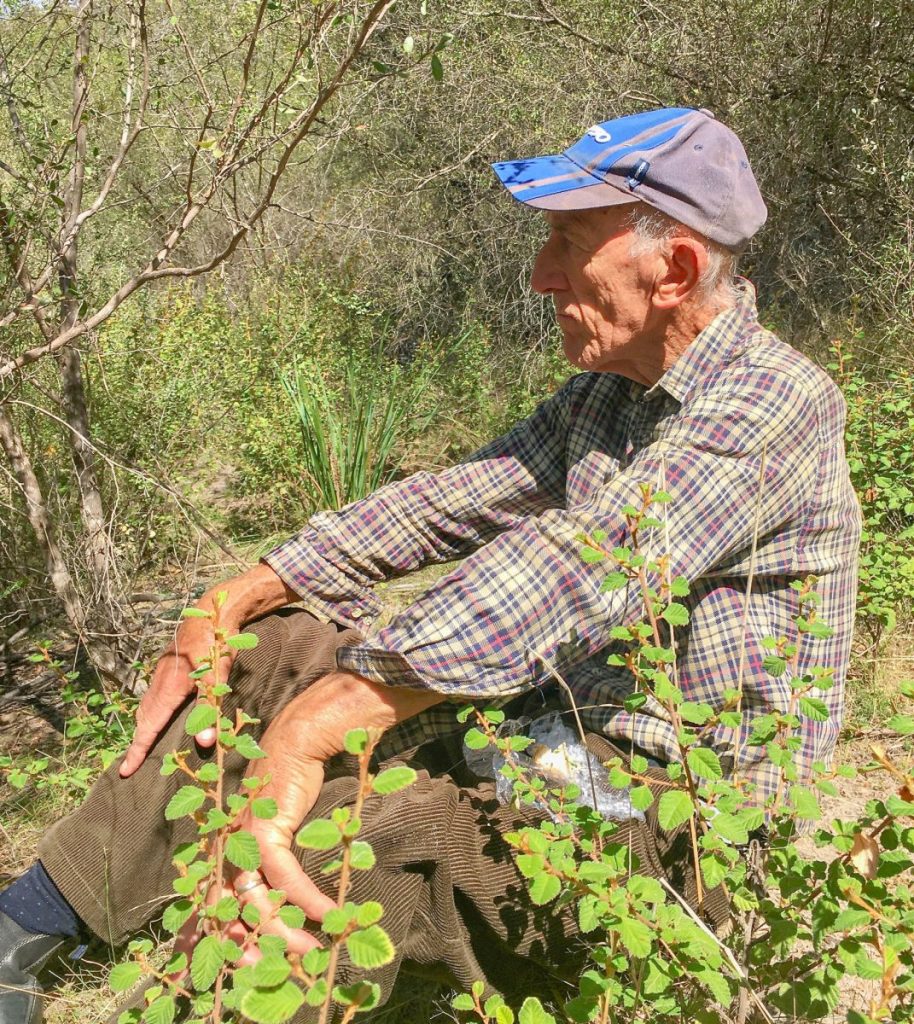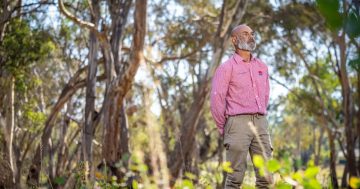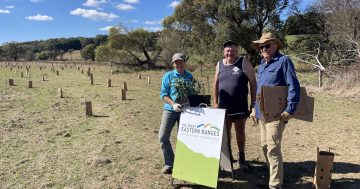
For a limited time each year native pea plants can be harvested for seeds, and Tim Hayes makes the most of this opportunity to propagate species. Photo: John Thistleton.
Happy Wanderer creepers have climbed up so many garden fences and verandahs, splashing vivid purple along the way it’s become a well-known Australian pea plant.
Former science teacher and life member of the Australian Plant Society Tim Hayes draws on the Happy Wanderer when introducing novices to the world of native peas.
“It’s a pea because it has five petals in a particular configuration in the flowers,” he says. “It’s the colour and little white dots I think on two sides of the petal that makes it attractive to people.”
Few people are interested in native peas – the Happy Wanderer is an exception – and most go for the more glamorous grevilleas and eucalyptus.
“The reason for that I believe is all the pea plants have fairly small flowers,” Tim says, pointing to his little fingernail.
Tim on the other hand is enthralled by native peas, and is a happy wanderer himself along roadsides looking for them near Goulburn, where he lives. Thirty years ago he discovered a new specimen of pea at Windellama, southeast of Goulburn. Bright yellow with a reddish edge in the centre, it resembled other well-known peas. The National Herbarium of NSW at the National Botanic Gardens in Canberra identified it as another species found around Windellama. Tim agued it wasn’t.
“They arranged an interview for me with Professor Mike Crisp, the top man in peas all over Australia,” he said. “He looked at it and said it was not covered in the flora of NSW. So it was a new species.”
Eventually the species, named Dillwynia glaucula was officially recognised and recorded. It is found at Windellama mainly, and one or two rare species are at Michelago. It’s commonly known as the Michelago parrot-pea.
“It was a terrific lift altogether; you know it is really special to find something new,” Tim said. “In almost any sphere of life, if you do something new, it gives you a bit of a boost. And I have been looking ever since, over every square inch of Windellama for any pea plant that is different.”
His discovery was not made in some secret location, as people might imagine. It was on the intersection of Claypit and Oallen Ford roads near Windellama, and came to light only through his intense interest in pea plants and close observation.
Tim studied chemistry, physics, mathematics and mathematical physics at the University of Ireland, Galway College, before migrating to Australia and teaching in Sydney, where he became fascinated in eucalyptus trees. He identified 45 species around where he was living.
While teaching in Western Sydney, he took groups of his pupils to Murphys Glen in the Blue Mountains. “I was struck by the vegetation of the Blue Mountains; it is just superb in my opinion – there are native plants everywhere,” he said.

In his element in the Australian bush, Tim Hayes has often been called on to provide his vast knowledge and seeds to help rehabilitate the Goulburn region’s landscape. Photo: Australian Plant Society NSW.
His interest broadened to pea plants, and when he moved to Goulburn as a science and maths teacher in the 1980s, he began wandering roadsides and with three other like-minded enthusiasts formed the Southern Tablelands branch of the Australian Plant Society.
Acknowledging his years of writing newsletters and fostering interest in native flora, the society awarded him life membership in 2023, and said he had an extensive seed bank of local pea species and had supplied seed to the National Arboretum in Canberra.
Operating from the arboretum, a group known as Southern Tablelands Ecosystems Park who aim to reproduce all the ecosystems in this region, use Tim to guide them along roadsides around Windellama and Bungonia looking for new species.
He is still gathering the seeds of pea plants during the narrow window their flowering and seeding allows. The Southern Tablelands branch of APS has revegetated sections of the Upper Lachlan Local Government area, and Tim was instrumental in gathering seeds to help establish the Goulburn Wetlands.
He says pea plants improve the soil. “They will grow in parts where other things will not grow, so it is important to have them,” he says. “My belief would be try and preserve anything that has been put there by nature.”









